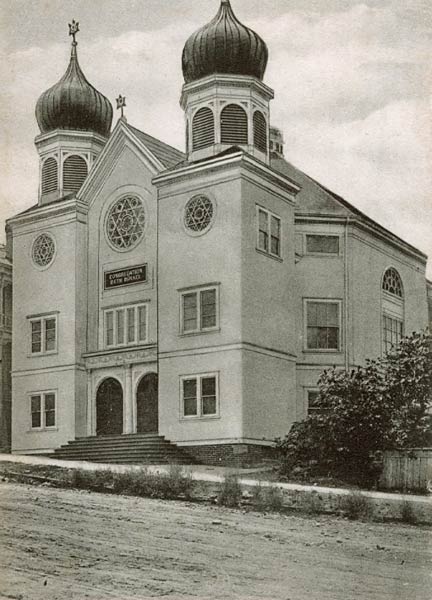
A Visit to Old Los
Angeles
12. Olive Street and Third
Street.
by
Brent C. Dickerson
Copyright © Brent C. Dickerson
Index to Episodes (click here)
A Visit to Olive Street, Third Street, Angels
Flight, and
the Auditorium.
| • On the west side of Olive Street, just south of its corner with Temple Street, we found the temple of the Beth Israel congregation. Young Frederick Johan read, "'Corner-stone laid July 14, 1901'—hmmm," said he, "Bastille Day." This exasperated Charley, who said, rather curtly, "I'm sure Bastille Day had nothing to do with it!" Young FJ continued reading, "'Dedicated April 13, 1902.' I wonder if that was a Friday the 13th...?..." Minnie rolled her eyes. FJ knitted his brow for a moment, then, quoth he, "Just what do they do in there?" Mother, who as I need not tell you, is a bit difficult about other religions, offered a huffy, "I'm certain that I don't know!" Papa looked up at the building and said, "Well, I'm not sure precisely; but they honor God, yes they do, that's my opinion...", and darted just the slightest sharp look at Mother. |  |
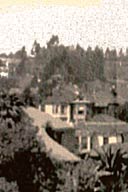 | • This house at center facing the viewer was located on the west side of N. Olive Street just south of Court Street at about address 147. |
• Continuing south on Olive Street, we find these houses in the low 100s of N. Olive Street. Our view is from the northeast.
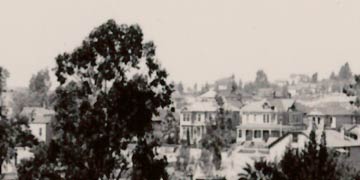
• Here, from a distance to the southeast, we see the portion of mainly residential Bunker Hill west of Broadway, and between First St. and Temple St. To orient yourself: The Court House (on Pound Cake Hill) can be seen at the extreme right; the tower of the High School (on Fort Hill) can be seen to the left of that. The large white building with all the gables in the center of the picture is on the northwest corner of Broadway and First Street. The cliff prominent in the left half of the picture rises above First Street just beyond Hill Street. Just to the right of the cliff we see a building characterized by covered terraces one above another for several stories. This was the hotel/boarding house called the "Highland Villa," a building which is a familiar landmark in early pictures of Los Angeles. Where is the summit of Bunker Hill today? Gone!—like most of Pound Cake Hill and Fort Hill. Before moving on, note the flagpole on the far left of this view...

• ...And now note that, in the below, the same flagpole is on the right. Here is the southern extension of Bunker Hill, rising on the far side of Broadway (the street below us in this view) and Hill St. Familiar City Hall, in the 200s block of Broadway, dominates at the left; the Victorian Gothic building in the center foreground is at the southwest corner of Broadway and Second St. Looking further into the view, we can see Second Street climbing over Bunker Hill. The hill area was well into its metamorphosis from being an enclave of single-family residences to being the apartment and hotel precinct. Those trying to "learn" the look of Los Angeles in this era (the view is from 1909) will be able to test themselves by returning and identifying in this shot many of the buildings we will see in close-up over the next few episodes.

• Turnabout is fair play; and so we flip from looking from downtown to Bunker Hill to looking from Bunker Hill towards downtown. In the view below, from a vantage point which seems to be the top of a building near the corner of North Hill Street and Court Street, thus north of First Street, we look down on the downtown flatlands for a vista from the (unglamorous back of the) Bryson Block, the prominent building in the mid-distance at left, located at the northwest corner of Second Street and South Spring Street, to the church which we see at center, located at the southeast corner of Second Street and Broadway, with City Hall beyond in the 300s block of Broadway, and then, continuing to the right, miscellaneous buildings in the block between First Street and Second Street to the west of Broadway. One strains to see any more buildings which are familiar; finally the eye lights on the little flat building near the foreground at left. That is the building on First Street, a little west of Broadway, housing "J.B Walters, Printer; Linotyping; and Assay Office," which we saw as we approached Hill Street to begin our visit there (fifth picture down in that episode). Just in front of that building, we see a small stretch of First Street itself. We look in vain for the big Police Station and Jail which was built just west of that little building—it isn't there! That's because it was built in 1895, meaning that this photo was taken prior to that year. However, we do see a friend we just met: Look at the big tree just left of center two views above; that is the tree whose branches barely edge into our present view at upper right; and it is the house we see behind it, in the view two above we just looked at, from which this present view was most probably taken.
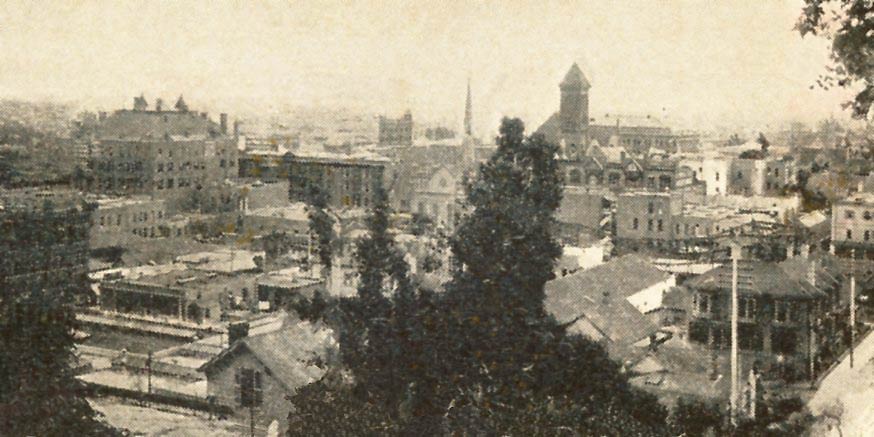
• Returning to closer shots, we have a view of the east side of the high 100s on Olive, all the more valuable as we can orient ourselves by some buildings we know in the distance. Olive Street crosses immediately below us. The Olive Court area which we saw a bit of when we were examining the 100s block of Hill Street is, in this view, the cluster of houses on the left. In the middle of the view, in the middle distance, the tower of City Hall beckons on Broadway; half of the the Chamber of Commerce building on the same street is at the mid-left edge; and that familiar landmark the Union Trust Building at Spring and Fourth can be seen, hazily, close to the right edge near the middle. Is the town deserted? Not a human, horse, dog, auto, or bird to be seen!
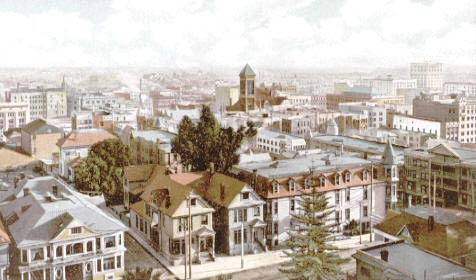
• Now we are looking at the west side of the south 100s block of Olive Street. It is difficult to make out the line of the street; but the two houses at center right face onto Olive. The building which dominates at left, and which we have seen in other views, is at the southwest corner of Olive and Second Sts. The Argyle Hotel, built in the 1870s, can be seen closer to us, kitty-corner to it.

• As we walked past the Argyle Hotel, we found a photographer taking a picture of this group of people at the side entrance. Young Frederick Johan tapped the photographer on the shoulder—said photographer was a short man, fortunately for FJ—and asked what the occasion was. "Oh," quoth the man, "this whole clan is traveling the West together, and . . . " An imperious gent from the family group shouted over, "Pay no attention to passers-by and vagabonds; let's get on with it!" And so we kept walking.
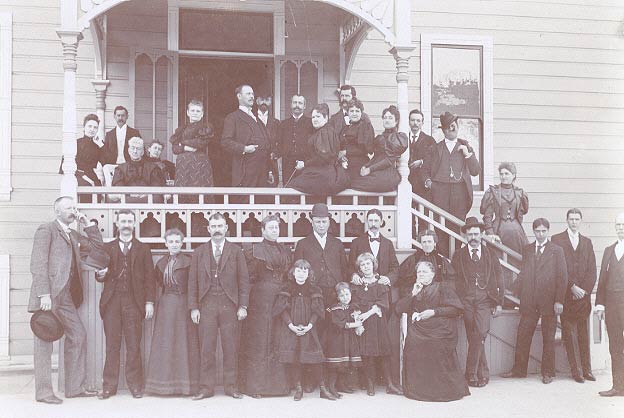
• We look west up Second Street to the southern corners of its intersection with Olive Street (in the center of the view; across the street from the unseen Argyle Hotel) and beyond nearly to the southeast corner of Second and Grand Avenue. The edge of the Hotel Northern back at the corner with Clay Street is at the left. The building at the center right of the second view previous to this can be seen at the left of the intersection in the present view.
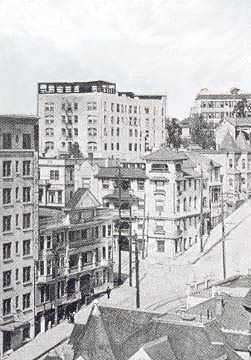
• The lower 200s of South Olive Street (the Hotel Cumberland is at address 243). In the distance, "above" the Hotel Cumberland, we see a stretch of North Olive Street, atop Bunker Hill. "'Tis a calm street, at last!" declared Mother; "Any street where the neighbors can't hear a baby cry is not a humane street, is my opinion. Having a baby, and protecting it, is what human civilization is all about!" Anna turned to Papa and queried, "I wonder how many neighbors' babies one would like to hear?" "Ja," he said, "as many as humanely possible, I think." This seemed a little ambiguous to me, dear; but, noticing Mother's cocked eyebrow, I didn't pursue it. As for the Baby, he too found that the wisest course was to maintain silence.
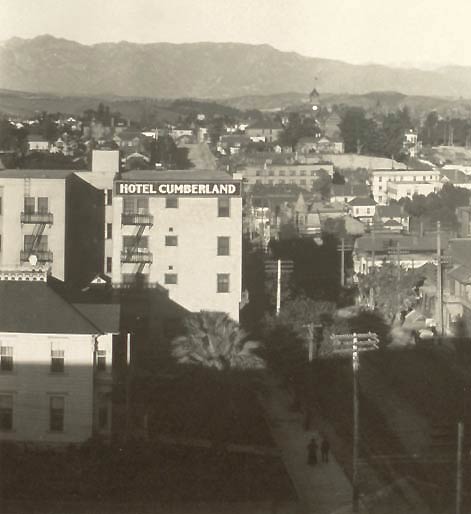
• Young Frederick Johan, however, declared that he would get information on how things were if you had a baby and lived in the neighborhood, and ran up to a young Miss who had started up the steps to the Hotel Cumberland. ("He should have left that to me," pouted Charley.) "Pardon me," said he to her, "but I'd like to speak to you about having a baby..." She shrieked "Oh!", blushed, slapped him, and exited hastily into the hotel. Minnie helped him up, saying "The moments for young men to talk to young women about babies must be chosen with great care, brother dear!"
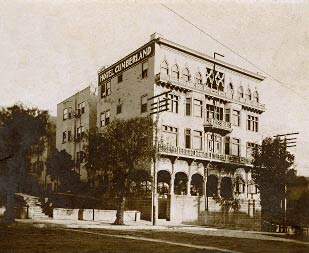
| • Here is a view from the low 300s of Olive Street, looking eastward towards City Hall on Broadway. The building to the right of the right-hand palm is the Fay Building, at the southeast corner of Hill and Third Streets. |
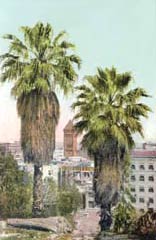 |
• The east face of Olive St. where it changes from the 200s to the 300s. Where's the eastern corner with Third Street? There isn't any corner, as Third Street tunnels beneath us. That's the upper terminus of Angels Flight at center bottom. Dominating at lower right is Lodge 99 of the Benevolent and Protective Order of Elks. Examination of the background will reveal the Chamber of Commerce Building on Broadway, and the Phillips Block (with the "Great White Department Store") way back at Spring and Franklin Streets. Meantime, Olive Street itself edges placidly into the view at lower left.
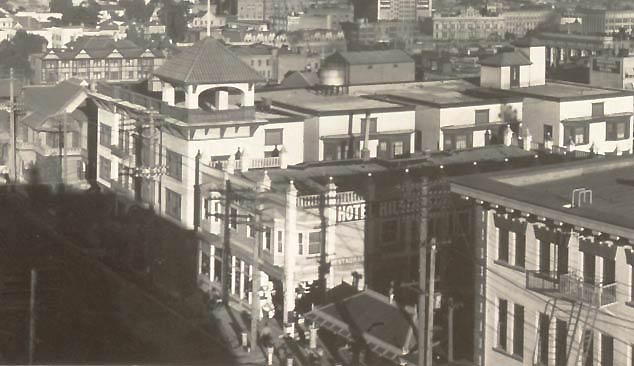
• Speaking of Third Street, let us vary our modus operandi. For a bit of a spree, let us walk for a moment not north to south, but east to west, criss-crossing where we have been. Let's start at Main and Third Street, looking west. Focus on the tunnel at the far end of the street.
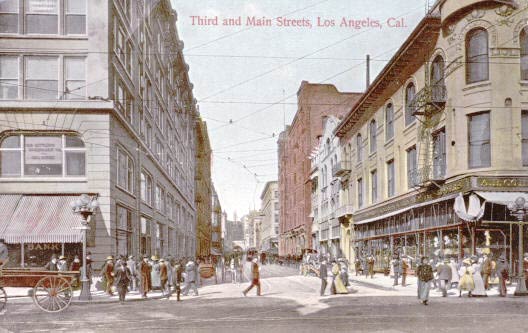
• We walk half a block west. "It certainly has become a gray day all of a sudden," said Anna. "I'd call it 'sepia'," I said.
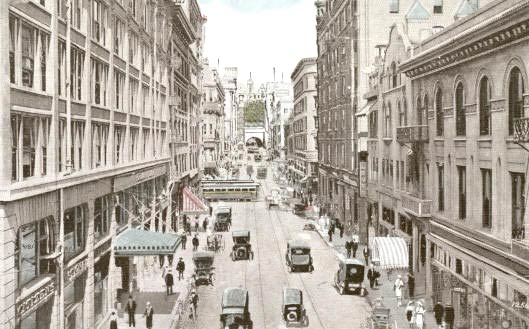
• Another half block, and we approach the corner with Spring Street. We know this intersection well from our Spring Street walk! That's the Ramona Hotel coming up on the left, the Douglas Block coming up on our right, and the American Savings Bank immediately to our right. Soon we'll pass that barber shop again—don't mention Minnie's woolen underwear!—but we keep walking west towards the tunnel.
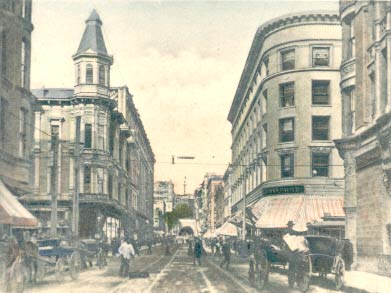
• We cross Spring, and here we are, looking west from the intersection of Broadway and Third. The Bradbury Building (unseen) is immediately to our left. "How exciting," yawns Minnie.
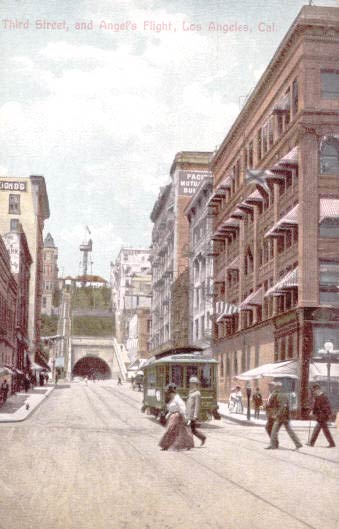
• We approach Hill Street, and see the beloved Angels Flight funicular railway going up the hill to Olive Street, meantime passing over little Clay Street.
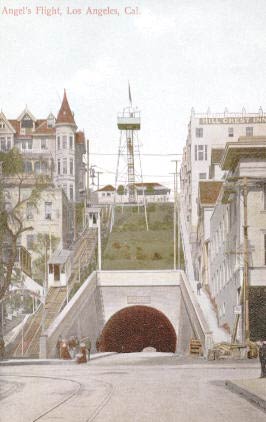
• A panorama of the route and surroundings of Angels Flight. Note the observation tower (called "Angel's View"), the light-colored building with the "patio roof", at the center of the view (in front of the Victorian mansion), and the evergreen tree silhouetted against the sky on the left.
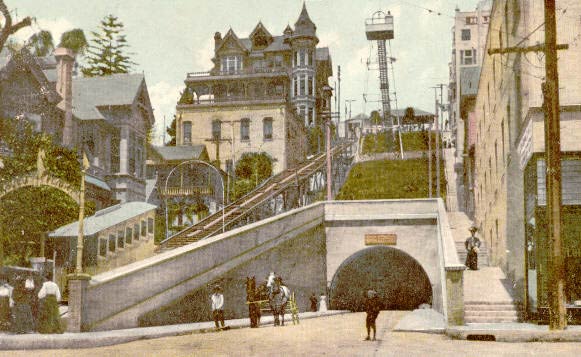
• We ride Angels Flight up to Olive Street. Let's glance back at the route we have taken. Hill Street crosses just below us, the Exchange Building to the left, the Fay Building to the right. Broadway is a block farther, and we can make out the Bradbury Building. If one knows what one is looking for, the Douglas Block at Spring and Third can be made out. Though it appears from the picture that Third dead-ends at Main in the distance, it actually recommences its course east a few yards to the south on Main.
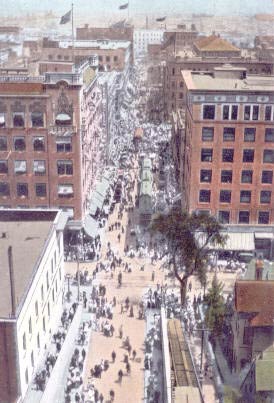
• Young Frederick Johan, who had a positive mania for climbing things, wanted to go to the top of Angel's View to see what was what; Charley and I trudged behind him all the way up. Remember the building with the "patio roof"? Here it is, just below us, before the roof was enclosed; and below it, across the street, is the evergreen tree we also saw from the other side— it's in the backyard of a house which remains from the residential days of Hill St., of which we see the east and west sides of the mid-300s as we look southeast over the city.
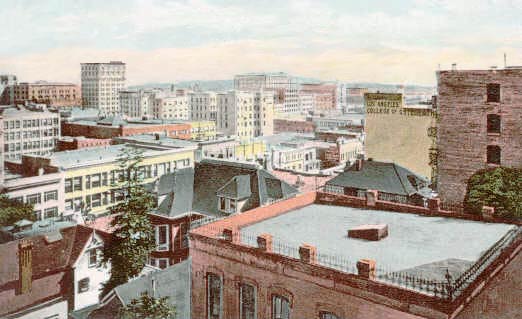
• As we climbed down from the observation tower, a team of very quick workmen built the rooftop patio alias "roof garden" on the top of that building, the location of the Elks' Club—which is to say The Benevolent and Protective Order of Elks, B.P.O.E. Lodge No. 99—the members of which kindly invited us in to take in the view northeast towards the Court House.
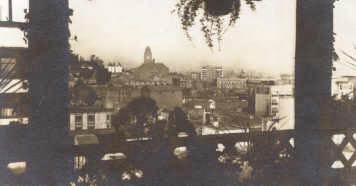
• We exited the Elks' building from its Olive Street entrance. In the view, we can see the rooftop patio garden at back, and, beyond it, just a bit of the building at the southeast corner of Hill and Third Streets.
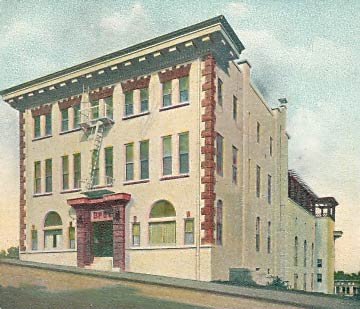
• The Ems Hotel & Apartments was built across the street at 321 S. Olive Street. Note the grade of the street ca. 1905-1906. "I am very glad we're walking downhill!," Mother said, with a sharp look at Papa. Papa sighed and volunteered—if "volunteered" be quite the right word—"Why don't I carry the baby for a while? Come to me, my little one..." The name of the building comes from that of its original builder-owner, Charles Clayton Emswiler, who resided there until his death July 14, 1922.
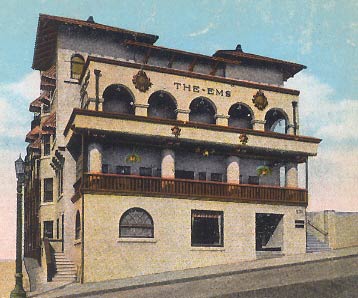
| • Olive Street, in its mid-300s addresses, crosses left to right, north to south, about at center in this view. In the background at right, the tower of City Hall on Broadway asserts itself. | 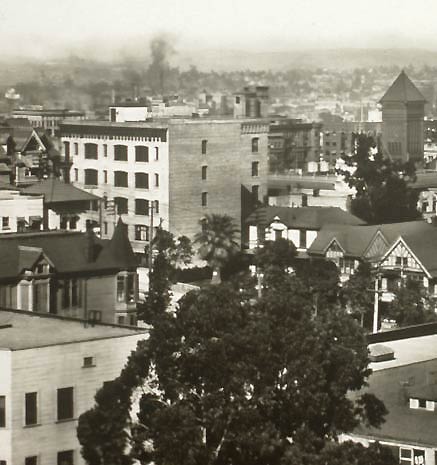 |
• There were some charming residences on the east side of the street.
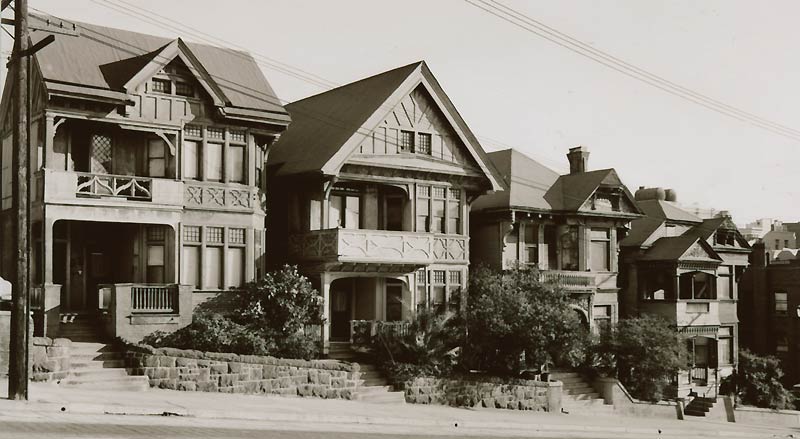
• We continue southwards along the east face of the 300s of South Olive Street . . .
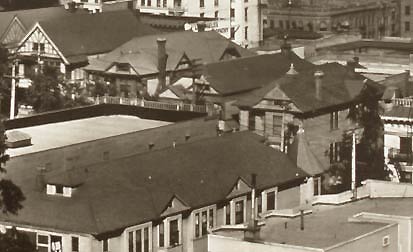
• . . . And finally we approach its corner with Fourth Street. The familiar domed building at the northeast corner of Hill and Fourth streets can be seen at mid-right, emerging from a deep shadow. Where's Clay Street? Modestly running parallel to, and between, Hill and Olive, from this standpoint one would never suspect it to be there. Its shy course ends at Fourth Street. The large building which dominates in the foreground at right—we see its back—is the Hotel Antlers we saw earlier from Hill Street. Minnie sniffed the air. "What is that oppressive odor?", she asked. "Garlic," quoth I; "I think that, or that, must be the roof of Delmonico's down on Hill St." Minnie fanned herself vigorously. "Oh, how these households must suffer!"

• The Fremont Hotel lends its handsome presence to the southwest corner of Olive and Fourth. We are on a hillside!—note the angle upwards of Fourth Street, and the angle downward of Olive as it runs south. The building just beyond the Fremont is the Olive Street School. The trees we see at right in this view are the trees we see from another perspective at center in the above view; indeed, from the size of the trees and their branches, it appears that these two photographs were taken at about the same time.

• The guests at the Fremont had good views over downtown in several directions. First, let's look north, back up the 300s block of Olive Street where we were just strolling along.
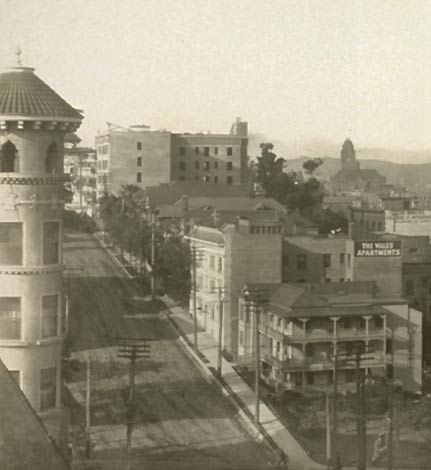
• Now we look east, down Fourth Street back to the center of downtown. We recognize the domed building a block away at Fourth and Hill; two blocks east at Fourth and Broadway is the building which had the lady's shoe on it—the Grant Bldg.—and three blocks east, at Fourth and Spring, towering over the rest of downtown, is that ever-present grand old landmark, the Union Trust Bldg., alias Braly Bldg. Immediately below us, we some see houses and yards; the house immediately at the southwest corner of Fourth and Hill is about the be replaced by the Wright-Callender Bldg., as we'll see in the following view. "I can see the Westminster Hotel at Fourth and Main," declared young Frederick Johan. Minnie sighed and said—without much spirit, is my opinion—"Good for you."
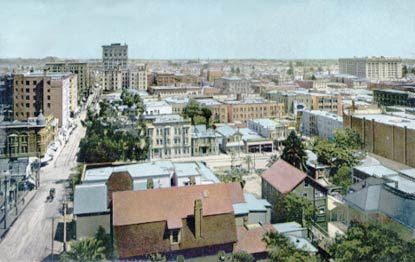
• We look southeast from the northwest corner of Olive and Fourth. That's a corner of the Fremont at the right, the tower from which we took our previous view; the Wright-Callender Building (which we saw from its front when we visited Hill Street) has replaced the house at the corner below, and dominates the center left. Over on Fifth Street between Broadway and Hill, the Hotel Alexandria—which the postcard lab has decided to make brick-red in color—is prominent at the center. We again note relictual patches of old suburbia, with its houses, gardens, and trees, reminding us of the area's diminishing past.
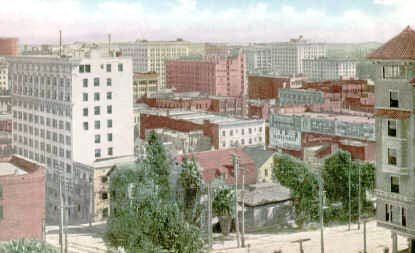
• An examination of the vista to the south reveals many buildings familiar to us: Jevne's, at Broadway and Sixth, the back of the California Club at Hill and Fifth, the new location of Hamburger's Department Store at Broadway and Eighth. Closer in below us, we see a few remnants of single family homes defying urbanization for a few last moments. The photographer was standing on the roof of the Trenton, which we'll see in just a moment.
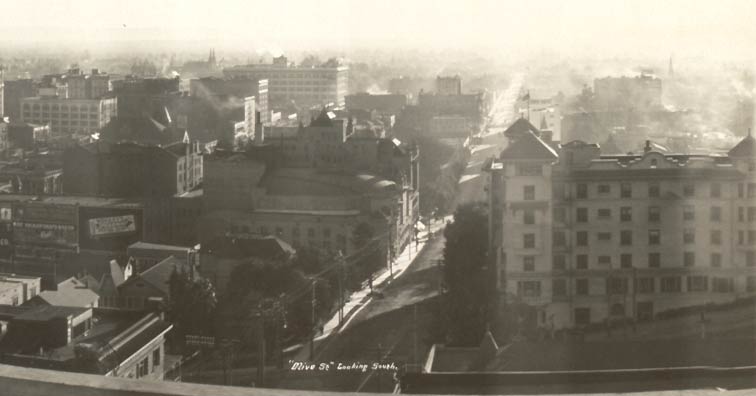
• This stretch of Olive Street was prominent from the viewpoint of dwellers on the flatlands (earlier Angelenos called the area the "Plains") of downtown. Viewing from the east, we see the 400s block of Olive Street crossing at center, the Hotel Trenton, the Olive Street School, and the Hotel Fremont looking us dead straight in the eye. Looking beyond, we get an idea of the general nature of the Bunker Hill neighborhoods of Grand Avenue and Flower Street.
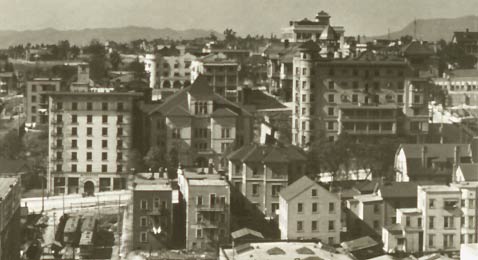
• More modest in design than the Fremont is the Hotel Trenton, two doors down from the Fremont (which latter can be seen to the right in this view); a remainder from residential days perseveres on the near side of the Trenton.
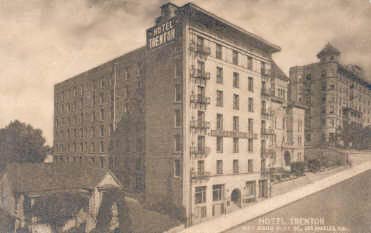
• As we passed the Trenton, I decided to glance inside. Just as I reached for the door, a young couple came out, the pale missis rolling her eyes and saying, "I can't sit in there another moment, Roland—no I can't—I'm positively sea-sick! O, for fresh air and a stable repose!" As we passed in the doorway, the man sighed deeply and said, "But dear, the stables are several blocks away!" I walked in and saw that every chair—every chair—was a rocking-chair. And, looking on a scene of a dozen people rocking, I felt a bit wobbly myself.
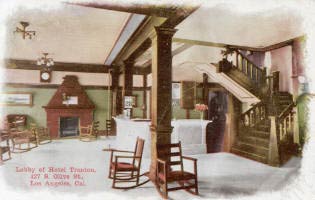
• Across the street from the Trenton is the modest but cozy Hotel Munn, at 438 S. Olive.
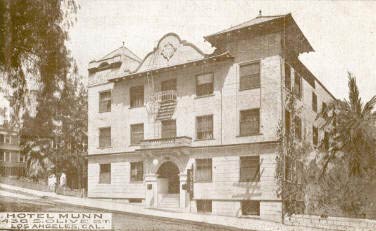
• Again from on high, we see the 300s and 400s block of Olive (going diagonally through the center of this view). The Auditorium and Central Park dominate in the foreground. Grand Avenue is at upper left, and Hill Street at lower right. The cross streets are hard to make out; but 4th Street crosses at about the center; the Wright Callender Building, at the southwest corner of Hill and 4th, is the large white building prominent at center right. The lower white building on the east side of Olive Street at nearly dead center in this view is the Hotel Munn.
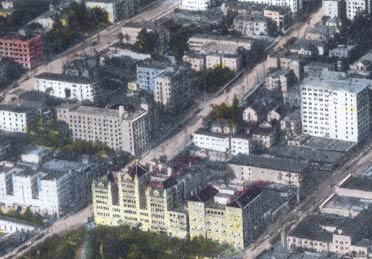
• We approach the corner with Fifth Street, and see a bit of the high 400s on the west face of Olive Street across from the Auditorium. The light building at the left is the Auditorium Hotel; the Auditorium itself is at the right.
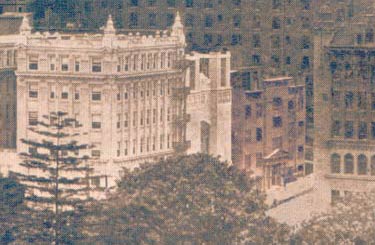
| • An angled glimpse of the east face of the 400s block of Olive Street. | 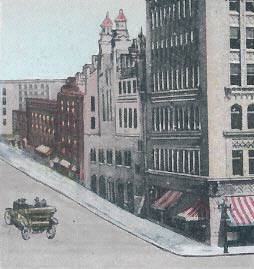
|
• The corner of Olive and Fifth Street
brings us to territory familiar to us—the main face of the
Auditorium, and Central Park. We look up at the imposing but graceful
front of the Auditorium, which faces the park—we also see the
California Club on its far side—and then we focus on the view east on
Fifth Street from its corner with Olive. The presentation at the
Auditorium must be "Robin Hood"; at least, so says the banner over the
street (facing the other way)!
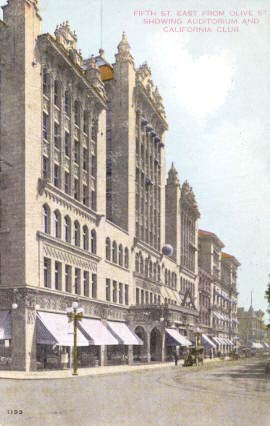 | 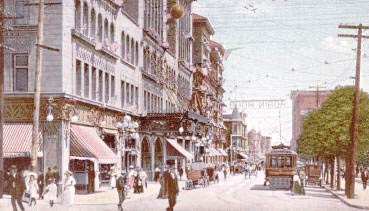 |
• Papa has arranged a treat. "Aunt Sigrid," says he, "has a friend whose boy takes tickets at the Auditorium. He is meeting us here, and will slip us in the side way for a look!" As it happens, Chester—boy of friend—is a bit late—in fact, he is rather late indeed, such being the easygoing lifestyle of the southland—but the womenfolk take the occasion to cross over to the park and sit in the shade while the children play. Ah, here is Chester!—who led us through a side door, and conducted us through some dark passageways until we stepped through a door and the stage opened out in front of us. "Did you know," asked Chester, with the detached superiority of a tour-guide, "that this is the world's largest concrete building of this sort?" Young Frederick Johan exclaimed, "Another 'world's largest'!", while Papa observed "'Of this sort'!—well"—and at this point he took a puff on his cigar—"I think, indeed I do, that a man could 'sort' this in whatever way suited him at the moment." Chester sighed, but said nothing.
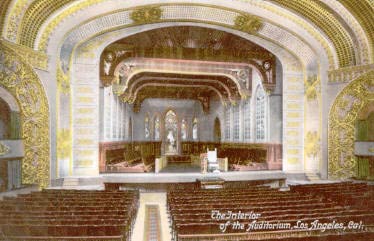
• We see that even the box seats are magnificent. Quiet stepsister Anna whispered, "It is . . . a palace!"
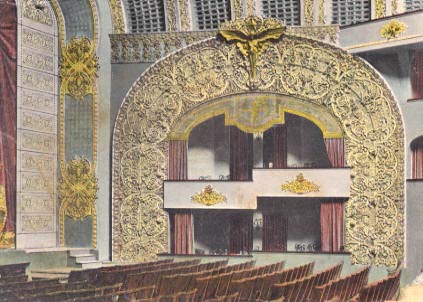
• Papa took a notion to leap up onto the stage, and—aside from Mother, the baby, and Anna—the rest of us joined him. As we stood on the stage, Papa boomed, "I do believe a man could stretch out in such a place, boys—indeed, I do believe so!" Chester stepped into the shadows.

• The newer Auditorium Hotel at the northwest corner of Olive and Fifth dominates the little old-fashioned boarding house near the southwest corner. Whether residing in new building or old, however, everyone could enjoy the greenery across the street in Central Park.
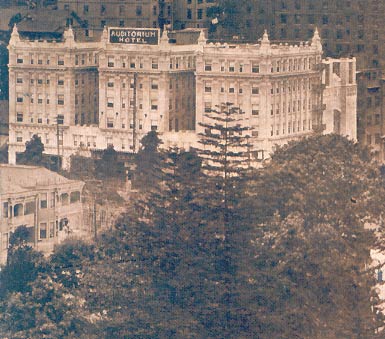
• Naturally, I had to poke my head into the lobby of the hotel. A bit more modern than the Lankershim, it seemed to me!
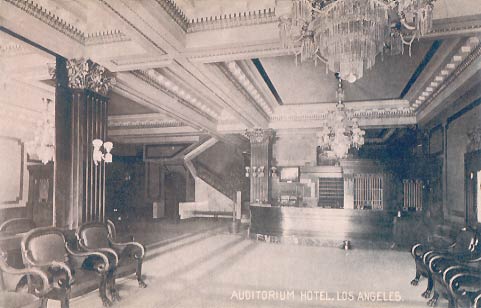
• Ahead lay Central Park. Before we crossed Fifth Street, Papa stopped us all, took my hand, and said, "My boy, how are your pickled beets today?", and laughed his hearty laugh. "Mr. S.," said Mother, herself scarcely able to suppress a smile, "please do not make a public spectacle." I sighed and said, "I'm going to stay on this side of the street. You others may wander in the park at your own risk." Now Minnie took my hand and said, "Ulf, dear, if you don't mind the company of a hoyden, I'll stay with you." "I don't happen to have any hoydens on hand at the moment ["Check with Charley," said Minnie as I spoke]; but do join me," I said, offering my arm.
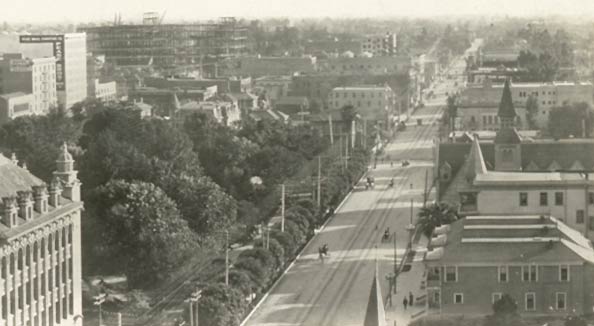
• The 500s block of Olive Street around the time of our visit exhibits the same elements of transition which we have seen previously. We see the whole stretch here, the east side of the street being Central Park, the west side having a church and several small hotels—all of which would be replaced by the grandiose Biltmore Hotel before long—and then a new office building at the extreme left of our scene, a building which stands at the northwest corner of Olive and Sixth Street. We can meantime make out the Auditorium at the right of our view; Chester remains in the shadows until the rural visitors are well out of sight.
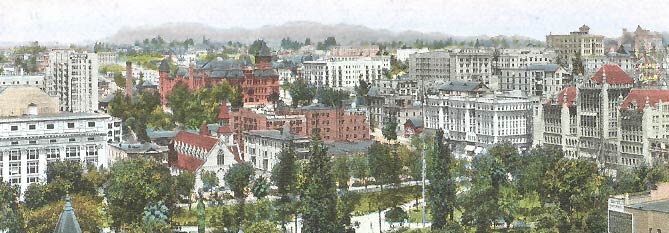
• Observable in many panoramic views of this part of Los Angeles is this church with its distinctive and rather beautiful steeple. This is St. Paul's Episcopal Cathedral, located at 523 S. Olive Street, about where the main "traditional" entrance to the Biltmore Hotel would later be. Shadows of the trees in Central Park across the street can be seen in this early morning shot.
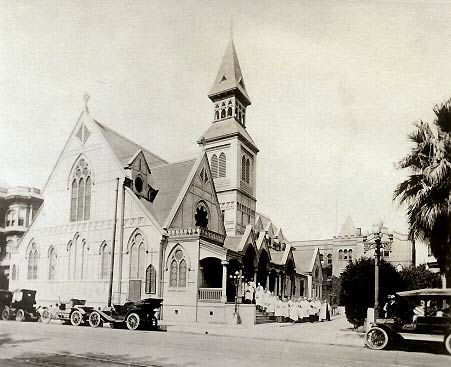
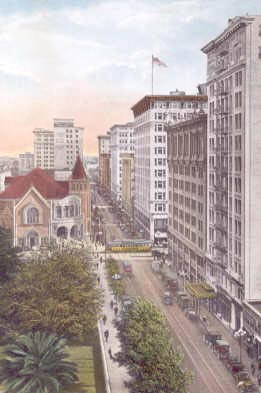 | • We look east (left), west (right), and north (below) from the corner of Olive and Sixth. In the northward view, the large brick-colored building near the center is the Hotel Trenton which we saw more closely a bit earlier. | 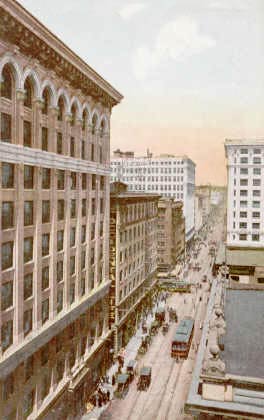 |
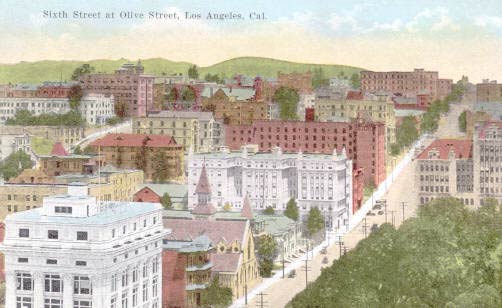
• This is the view from another angle looking north on Olive from Sixth Street.
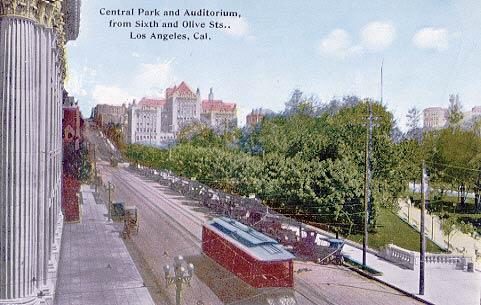
• As we look north on Olive from Sixth, the Pacific Life Building—on the northwest corner of that intersection—is at our left.
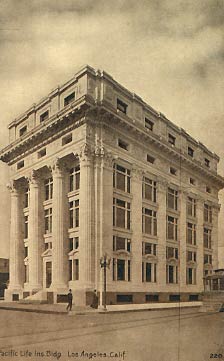
• West on Sixth Street from Olive from a different standpoint . . .
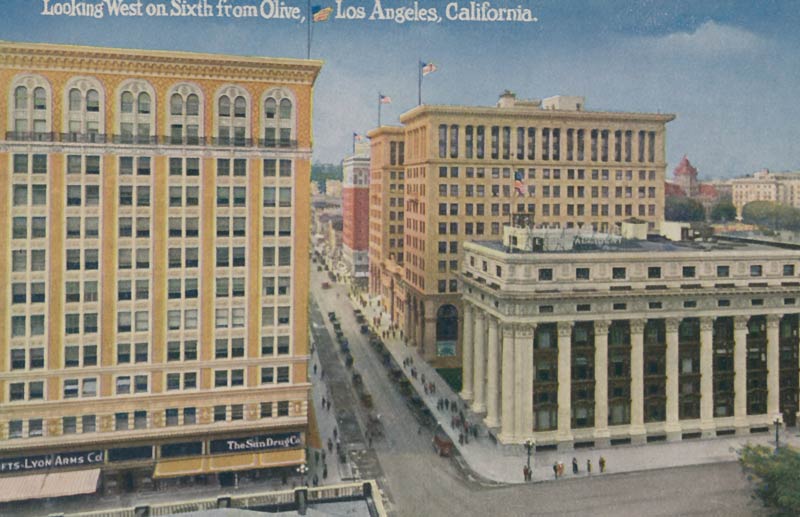
• We penetrate to the corner of Olive Street and busy Seventh Street. "Far enough!" we all cry at once, anticipating dinner at Aunt Sigrid's a few blocks away. "Even 'passers-by and vagabonds' need their rest now and then. Humph!," was how Mother summed up her feelings. But, before we leave, we can note the northeast corner of Seventh and Olive, with the Los Angeles Athletic Club Building dominating. This was formerly the site of the Baltimore Hotel, the new premises of which we saw on Los Angeles Street.
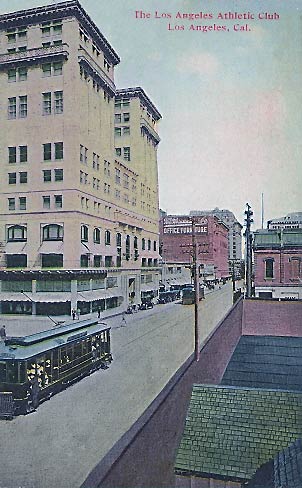
Return
to Hill Street and Central Park; or on to
Grand Avenue and the State Normal School . . .